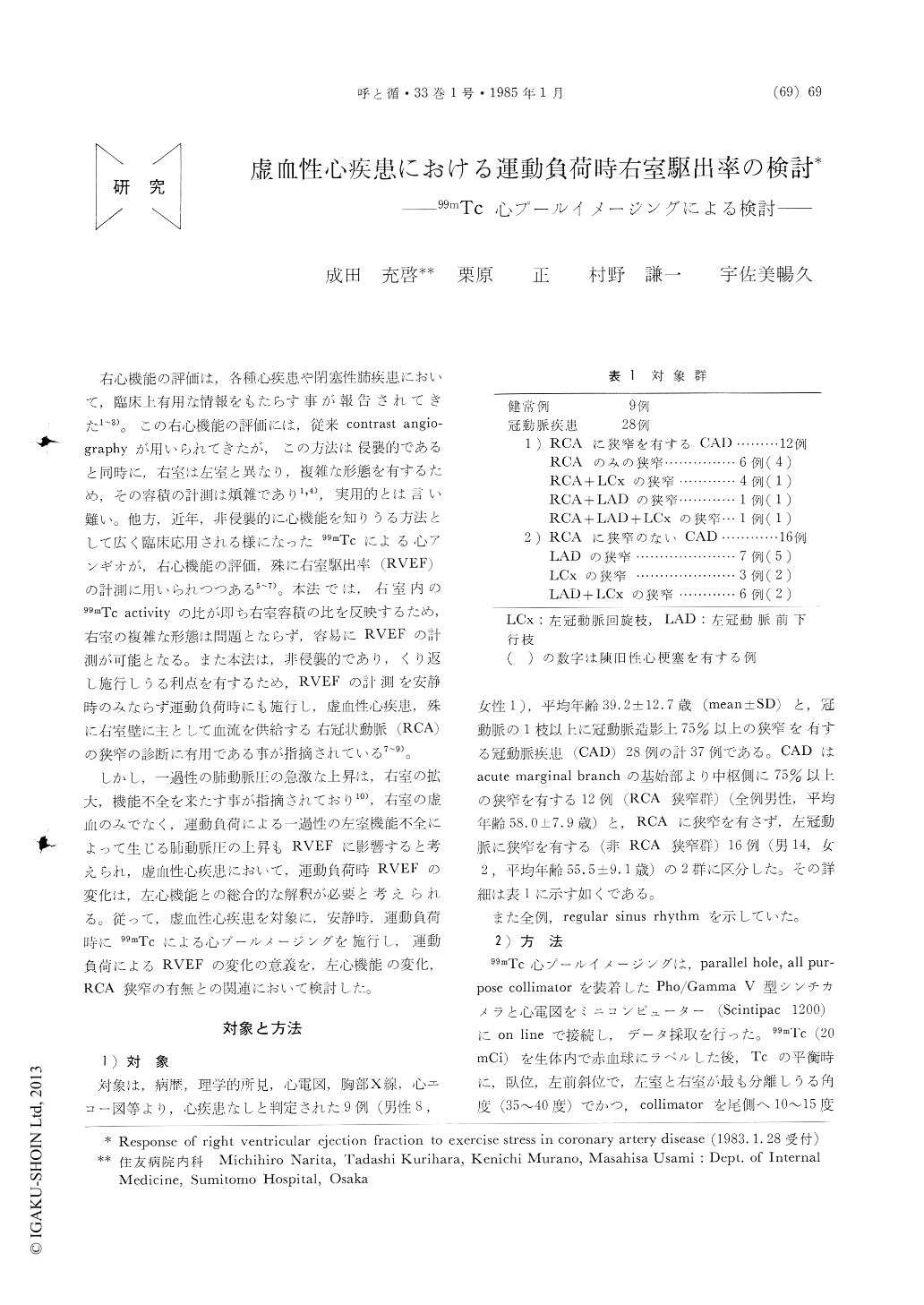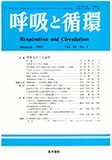Japanese
English
- 有料閲覧
- Abstract 文献概要
- 1ページ目 Look Inside
右心機能の評価は,各種心疾患や閉塞性肺疾患において,臨床上有用な情報をもたらす事が報告されてきた1〜3)。この右心機能の評価には,従来contrast angio—graphyが用いられてきたが,この方法は侵襲的であると同時に,右室は左室と異なり,複雑な形態を有するため,その容積の計測は煩雑であり1,4),実用的とは言い難い。他方,近年,非侵襲的に心機能を知りうる方法として広く臨床応用される様になった99mTcによる心アンギオが,右心機能の評価,殊に右室駆出率(RVEF)の計測に用いられつつある5〜7)。本法では,右室内の99mTc activityの比が即ち右室容積の比を反映するため,右室の複雑な形態は問題とならず,容易にRVEFの計測が可能となる。また本法は,非侵襲的であり,くり返し施行しうる利点を有するため,RVEFの計測を安静時のみならず運動負荷時にも施行し,虚血性心疾患,殊に右室壁に主として血流を供給する右冠状動脈(RCA)の狭窄の診断に有用である事が指摘されている7〜9)。
しかし,一過性の肺動脈圧の急激な上昇は,右室の拡大,機能不全を来たす事が指摘されており10),右室の虚血のみでなく,運動負荷による一過性の左室機能不全によって生じる肺動脈圧の上昇もRVEFに影響すると考えられ,虚血性心疾患において,運動負荷時RVEFの変化は,左心機能との総合的な解釈が必要と考えられる。従って,虚血性心疾患を対象に,安静時,連動負荷時に99mTcによる心プールメージングを施行し,運動負荷によるRVEFの変化の意義を,左心機能の変化,RCA狭窄の有無との関連において検討した。
The right ventricular (RV) response to exercisewas assessed in 28 patients with coronary artery disease (CAD) and 9 normal subjects.
The relationship between RV reserve, exercise left ventricular (LV) reserve and the presence of proximal right coronary artery (RCA) stenosis were evaluated.
RV and LV ejection fraction (EF) were deter-mined by multiple-gated equilibrium blood pool imaging with 99mTc in the modified left anterior oblique position. Graded supine exercise stress blood pool imaging were performed at the same position by using bicycle ergometer. For calculation of RVEF, variable ROIs were used.
In normal subjects, both RVEF and LVEF increas-ed significantly during exercise (%ΔRVEF 18.9 ±5.9%, %ΔLVEF 16.3±4.7%). Patients with CAD were divided into 2 groups ; CAD with proxi-mal RCA stenosis (alone or in combination with other lesions) (n=12) and CAD without RCA stenosis (n=12). There was no difference in RVEF at rest when normal subjects and CAD groups were compared (Normal 48.6±4.9%, RCA dis-ease 43.9±6.3%, without RCA disease 49.1±6.1 %). Although in both CAD groups LVEF at rest were significantly lower than that of normal sub-jects, there was no difference in LVEF when 2 CAD groups were compared (Normal 65.9±6.3%,RCA disease 52.1±10.4%, without RCA disease 50.6±12.0%). In both CAD groups, LVEF and RVEF showed decrease or no change during ex-ercise. Although magnitude of change in LVEF from rest to exercise (%ΔLVEF) was not signifi-cantly different in both CAD groups (RCA disease -4.1±9.0, without RCA disease -6.2±14.6%), %ΔRVEF was different significantly (RCA disease -16.0±14.3%, without RCA disease-1.4±14.1 %, p<0.05). In patients with RCA disease, 3 patients (25%) showed depression in RVEF with exercise regardless of the increase in LVEF. But in patients without RCA disease, no one showed depression in RVEF with the increament in LVEF during exercise. These findings suggested that prox-imal RCA stenosis is one major determinant of exercise RVEF response. But in 9 out of 16 pa-tients without RCA disease (56%) both RVEF and LVEF decreased during exercise. Besides, in pa-tients without RCA disease there was a significant linear relationship between the direction and mag-nitude of change from rest to exercise of LVEF and RVEF (r=0.69). These data suggested LV response to exercise may be another important factor which determines RV response to exercise, and RV dys-function caused in part by altered loading condi-tions due to LV dysfunction as well as RV ischemia.

Copyright © 1985, Igaku-Shoin Ltd. All rights reserved.


